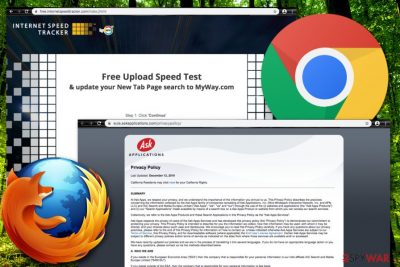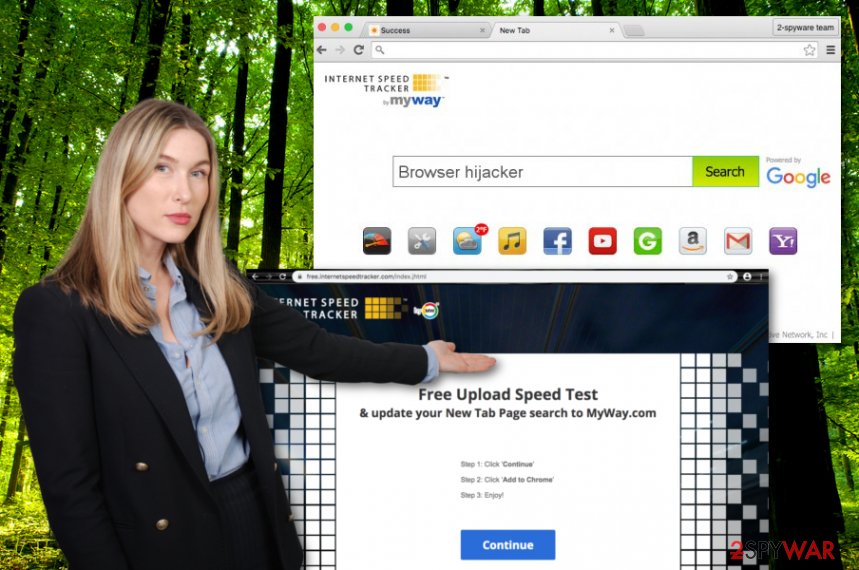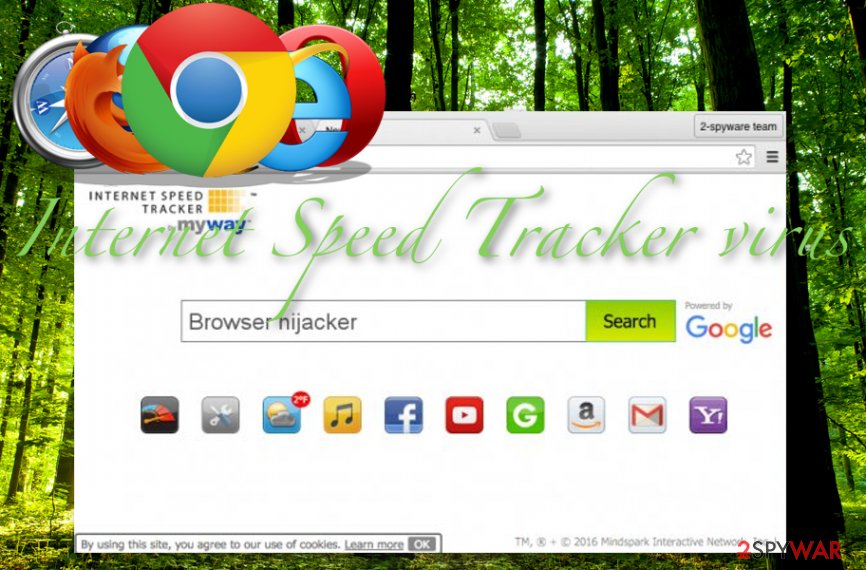Internet Speed Tracker (Easy Removal Guide) - updated Jan 2020
Internet Speed Tracker Removal Guide
What is Internet Speed Tracker?
Internet Speed Tracker – a browser hijacker that offers to check the Internet speed in exchange for setting the default search provider to MyWay.com

Internet Speed Tracker is a browser hijacker that offers to check upload and download speed but truly seeks to hijack your browser's new tab URL bar, homepage, and search engine. In fact, it has no use as there are other free apps that allow checking the Internet speed without modifying your web browser's settings. If you visit free.internetspeedtracker.com you will be offered to download the extension to Google Chrome. You should not rely on such services even though they promise to reveal useful tips on how to increase the Internet speed. Internet Speed Tracker Chrome extension should be removed once discovered on the web browser app as the PUP can initiate other unwanted activities such as advertising and redirecting.
Besides infecting Google Chrome, Internet Speed Tracker, developed by Mindspark Interactive Network Inc.,[1] can appear also on other web browser applications such as Mozilla Firefox, Internet Explorer, Microsoft Edge, and Safari due to a deceptive distribution technique known as bundling.[2] Afterward, the browser hijacker will not only modify your web browser settings but also might fill these apps with unwanted components such as rogue browser extensions, plug-ins, and cookies.
| Name | Internet Speed Tracker |
|---|---|
| Developer | Mindspark Interactive Network Inc. |
| Type/sub-type | Browser hijacker/potentially unwanted program |
| Target(s) | The suspicious application can appear on web browser applications such as Google Chrome, Mozilla Firefox, Internet Explorer, Microsoft Edge, and Safari |
| Changes | The browser hijacker sets the default search engine, homepage, and new tab URL as MyWay.com |
| Activities | Besides modifying the browser's settings, the suspicious application can display intrusive advertising notifications, redirect the user to affiliate sources, record information that is related to the user's browsing activities and history |
| Distribution | Software bundling is the most common technique used by PUP developers to spread browser hijackers. Additionally, these threats can appear through fake software updates |
| Elimination | You can get rid of the browser hijacker with the help of automatical software or by using the manual step-by-step guidelines that have been added to the end of this article |
| Fix tool | Try employing FortectIntego for fixing any corruption or compromisation found |
Internet Speed Tracker virus manages to enter the computer system seamlessly and modifies the user’s browser settings in the way this program wants. So basically it attaches to your Internet browser (Google Chrome or another one), and then it changes your homepage to Internet Speed Tracker search engine by myWay and it also installs Internet Speed Tracker Toolbar by myWay.
You should know that the logo “myWay” indicates that the program was developed by an infamous company that develops potentially unwanted software. This company is named “Mindspark Interactive Network.” You should not trust ANY application that is created by this company! It aims to generate pay-per-click revenue. Let us explain how Internet Speed Tracker app works and how it generates money for Mindspark.

Internet Speed Tracker provides an untrustworthy search engine, which, at first glance, delivers normally-looking search results; however, Mindspark aims to generate web traffic to its sponsors’ websites. This is why it replaces your previously-set homepage with its own search engine and sets it as your New Tab page as well.
You should never use this search engine because it delivers altered search results and you will not receive the information that you were expecting for. That means that Internet Speed Tracker supplements them with deceptive hyperlinks, which do not lead to accurate websites, but they cause redirects to third-party websites that pay Mindspark for promotion.
Keep in mind that some of the websites you might end up can be infectious, and that is the final reason why you should remove Internet Speed Tracker with no delay. You can do that using anti-malware software, which detects and deletes computer threats automatically. Additionally, if you have discovered any system corruption, try using software such as FortectIntego for fixing it.
Another reason to perform Internet Speed Tracker removal on your computer and web browsers is the possibility that this browser hijacker might record data that is related to your browsing activities. This means that all of your search queries, recently visited websites, hyperlinks and adverts clicked, saved bookmarks, and IP address will get tracked by the developers who employ cookies, beacons,[3] or pixels for such purpose:
We may collect information from you in a variety of different ways. This is information that may identify you, and anonymous information, such as the number of your page views, link clicks, and login times. Your information may be kept in an identifiable format, or in an aggregate format which means that you cannot reasonably be identified from it.
Nevertheless, Internet Speed Tracker might bring other potentially unwanted programs to the computer system. Often, browser hijackers come with additional threats such as adware, other browser-hijacking apps, scareware, technical support scams, etc. Be aware that some developers might even use potentially unwanted programs for the delivery of malware.
As you have read almost all of the reasons why you should uninstall Internet Speed Tracker from your machine, we want to add another one. If you keep this product on your computer system for a long time, its activities such as advertising and redirecting will likely get very intense and start eating your system's resources such as the CPU and GPU power. This might result in struggling applications (including browsers), constant computer crashes, freezes, slowdowns, and other symptoms.

PUPs use deceptive techniques to enter the computer system
Typically, the potentially unwanted software finds its way to the victim’s computer seamlessly and silently. Keep in mind that you can install such a program together with another free program that you wanted to have. This type of technique is known as software bundling. However, no one is going to tell you that your selected program promotes “third-party apps” unless you research it on your own.
According to experts from LesVirus.fr[4], you do not need to read all Internet forums searching for information about whether your desired program promotes dangerous software or not; you can simply find that out when you install a new program. All you need to do is to read the software’s Terms of Use (or End User License Agreement) document. You should find whether the program promotes sponsored freeware or not.
Moreover, you should set particular installation settings to avoid being infected with a browser-hijacking app without your consent. For that, set Advanced or Custom installation mode and then deselect the suggestions to install optional freeware. You should avoid configuration that is marked as Recommended or Quick as these modes allow the installation of all additional content together with the regular program.
To continue, other browser hijacker distribution sources can be found as fake software updates that are promoted by third-parties with the goal to push PUPs to random computer systems. If you are browsing the Internet sphere and accidentally encounter an update request, better visit the program's official website and see if there were any updates truly released recently or is it just a scam.
Removing Internet Speed Tracker
Typically, potentially unwanted apps can be deleted manually. If you are an experienced PC user, it will be a piece of cake for you. Regarding this fact, we have provided a manual removal guide below the text. There you will see instructing steps that show users how to remove Internet Speed Tracker from both the affected operating system and modified web browser apps such as Google Chrome, Mozilla Firefox, Internet Explorer, Microsoft Edge, and Safari.
However, if you are a less advanced computer user or have been running into a lack of time lately, the manual Internet Speed Tracker removal might not be the right option for you. In this case, you should try downloading and installing reliable antimalware software and eliminating the potentially unwanted program with the tool. Such products are capable of detecting the infection source in a few minutes of time and removing the cause safely and effectively.
You may remove virus damage with a help of FortectIntego. SpyHunter 5Combo Cleaner and Malwarebytes are recommended to detect potentially unwanted programs and viruses with all their files and registry entries that are related to them.
Getting rid of Internet Speed Tracker. Follow these steps
Uninstall from Windows
To get rid of the browser-hijacking application and clean your Windows computer from all suspicious components, apply these guiding steps.
Instructions for Windows 10/8 machines:
- Enter Control Panel into Windows search box and hit Enter or click on the search result.
- Under Programs, select Uninstall a program.

- From the list, find the entry of the suspicious program.
- Right-click on the application and select Uninstall.
- If User Account Control shows up, click Yes.
- Wait till uninstallation process is complete and click OK.

If you are Windows 7/XP user, proceed with the following instructions:
- Click on Windows Start > Control Panel located on the right pane (if you are Windows XP user, click on Add/Remove Programs).
- In Control Panel, select Programs > Uninstall a program.

- Pick the unwanted application by clicking on it once.
- At the top, click Uninstall/Change.
- In the confirmation prompt, pick Yes.
- Click OK once the removal process is finished.
Delete from macOS
Remove items from Applications folder:
- From the menu bar, select Go > Applications.
- In the Applications folder, look for all related entries.
- Click on the app and drag it to Trash (or right-click and pick Move to Trash)

To fully remove an unwanted app, you need to access Application Support, LaunchAgents, and LaunchDaemons folders and delete relevant files:
- Select Go > Go to Folder.
- Enter /Library/Application Support and click Go or press Enter.
- In the Application Support folder, look for any dubious entries and then delete them.
- Now enter /Library/LaunchAgents and /Library/LaunchDaemons folders the same way and terminate all the related .plist files.

Remove from Microsoft Edge
Delete unwanted extensions from MS Edge:
- Select Menu (three horizontal dots at the top-right of the browser window) and pick Extensions.
- From the list, pick the extension and click on the Gear icon.
- Click on Uninstall at the bottom.

Clear cookies and other browser data:
- Click on the Menu (three horizontal dots at the top-right of the browser window) and select Privacy & security.
- Under Clear browsing data, pick Choose what to clear.
- Select everything (apart from passwords, although you might want to include Media licenses as well, if applicable) and click on Clear.

Restore new tab and homepage settings:
- Click the menu icon and choose Settings.
- Then find On startup section.
- Click Disable if you found any suspicious domain.
Reset MS Edge if the above steps did not work:
- Press on Ctrl + Shift + Esc to open Task Manager.
- Click on More details arrow at the bottom of the window.
- Select Details tab.
- Now scroll down and locate every entry with Microsoft Edge name in it. Right-click on each of them and select End Task to stop MS Edge from running.

If this solution failed to help you, you need to use an advanced Edge reset method. Note that you need to backup your data before proceeding.
- Find the following folder on your computer: C:\\Users\\%username%\\AppData\\Local\\Packages\\Microsoft.MicrosoftEdge_8wekyb3d8bbwe.
- Press Ctrl + A on your keyboard to select all folders.
- Right-click on them and pick Delete

- Now right-click on the Start button and pick Windows PowerShell (Admin).
- When the new window opens, copy and paste the following command, and then press Enter:
Get-AppXPackage -AllUsers -Name Microsoft.MicrosoftEdge | Foreach {Add-AppxPackage -DisableDevelopmentMode -Register “$($_.InstallLocation)\\AppXManifest.xml” -Verbose

Instructions for Chromium-based Edge
Delete extensions from MS Edge (Chromium):
- Open Edge and click select Settings > Extensions.
- Delete unwanted extensions by clicking Remove.

Clear cache and site data:
- Click on Menu and go to Settings.
- Select Privacy, search and services.
- Under Clear browsing data, pick Choose what to clear.
- Under Time range, pick All time.
- Select Clear now.

Reset Chromium-based MS Edge:
- Click on Menu and select Settings.
- On the left side, pick Reset settings.
- Select Restore settings to their default values.
- Confirm with Reset.

Remove from Mozilla Firefox (FF)
To eliminate questionable browser extensions, add-ons, and plug-ins from Mozilla Firefox, complete the below-provided instructing steps.
Remove dangerous extensions:
- Open Mozilla Firefox browser and click on the Menu (three horizontal lines at the top-right of the window).
- Select Add-ons.
- In here, select unwanted plugin and click Remove.

Reset the homepage:
- Click three horizontal lines at the top right corner to open the menu.
- Choose Options.
- Under Home options, enter your preferred site that will open every time you newly open the Mozilla Firefox.
Clear cookies and site data:
- Click Menu and pick Settings.
- Go to Privacy & Security section.
- Scroll down to locate Cookies and Site Data.
- Click on Clear Data…
- Select Cookies and Site Data, as well as Cached Web Content and press Clear.

Reset Mozilla Firefox
If clearing the browser as explained above did not help, reset Mozilla Firefox:
- Open Mozilla Firefox browser and click the Menu.
- Go to Help and then choose Troubleshooting Information.

- Under Give Firefox a tune up section, click on Refresh Firefox…
- Once the pop-up shows up, confirm the action by pressing on Refresh Firefox.

Remove from Google Chrome
To properly clean Google Chrome from browser hijacker-added objects and modifications, you should follow these guidelines.
Delete malicious extensions from Google Chrome:
- Open Google Chrome, click on the Menu (three vertical dots at the top-right corner) and select More tools > Extensions.
- In the newly opened window, you will see all the installed extensions. Uninstall all the suspicious plugins that might be related to the unwanted program by clicking Remove.

Clear cache and web data from Chrome:
- Click on Menu and pick Settings.
- Under Privacy and security, select Clear browsing data.
- Select Browsing history, Cookies and other site data, as well as Cached images and files.
- Click Clear data.

Change your homepage:
- Click menu and choose Settings.
- Look for a suspicious site in the On startup section.
- Click on Open a specific or set of pages and click on three dots to find the Remove option.
Reset Google Chrome:
If the previous methods did not help you, reset Google Chrome to eliminate all the unwanted components:
- Click on Menu and select Settings.
- In the Settings, scroll down and click Advanced.
- Scroll down and locate Reset and clean up section.
- Now click Restore settings to their original defaults.
- Confirm with Reset settings.

Delete from Safari
Remove unwanted extensions from Safari:
- Click Safari > Preferences…
- In the new window, pick Extensions.
- Select the unwanted extension and select Uninstall.

Clear cookies and other website data from Safari:
- Click Safari > Clear History…
- From the drop-down menu under Clear, pick all history.
- Confirm with Clear History.

Reset Safari if the above-mentioned steps did not help you:
- Click Safari > Preferences…
- Go to Advanced tab.
- Tick the Show Develop menu in menu bar.
- From the menu bar, click Develop, and then select Empty Caches.

After uninstalling this potentially unwanted program (PUP) and fixing each of your web browsers, we recommend you to scan your PC system with a reputable anti-spyware. This will help you to get rid of Internet Speed Tracker registry traces and will also identify related parasites or possible malware infections on your computer. For that you can use our top-rated malware remover: FortectIntego, SpyHunter 5Combo Cleaner or Malwarebytes.
How to prevent from getting browser hijacker
Access your website securely from any location
When you work on the domain, site, blog, or different project that requires constant management, content creation, or coding, you may need to connect to the server and content management service more often. The best solution for creating a tighter network could be a dedicated/fixed IP address.
If you make your IP address static and set to your device, you can connect to the CMS from any location and do not create any additional issues for the server or network manager that needs to monitor connections and activities. VPN software providers like Private Internet Access can help you with such settings and offer the option to control the online reputation and manage projects easily from any part of the world.
Recover files after data-affecting malware attacks
While much of the data can be accidentally deleted due to various reasons, malware is one of the main culprits that can cause loss of pictures, documents, videos, and other important files. More serious malware infections lead to significant data loss when your documents, system files, and images get encrypted. In particular, ransomware is is a type of malware that focuses on such functions, so your files become useless without an ability to access them.
Even though there is little to no possibility to recover after file-locking threats, some applications have features for data recovery in the system. In some cases, Data Recovery Pro can also help to recover at least some portion of your data after data-locking virus infection or general cyber infection.
- ^ Mindspark Interactive Network. Wikipedia. The free encyclopedia.
- ^ Bundled software. Computer hope. Free computer help since 1998.
- ^ What is a tracking beacon?. Quora.com. Relevant questions and answers.
- ^ LesVirus.fr. LesVirus. Security and spyware news.























